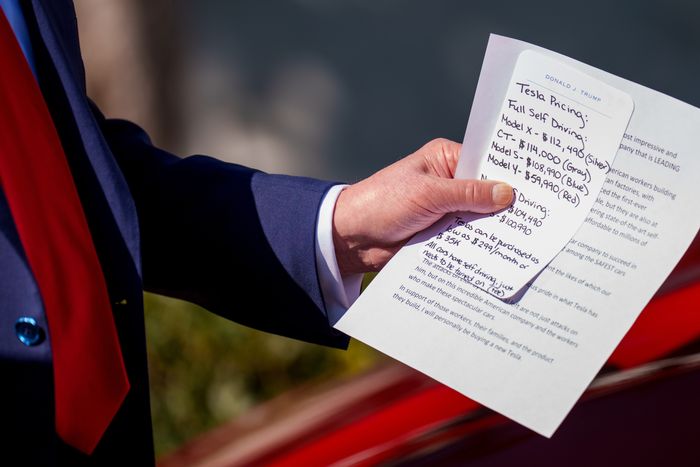Tesla Is Burning : All the bad news for Elon Musk’s EV company.
or most of its existence, Tesla being synonymous with Elon Musk has been an asset for the company. Though the world’s richest man was often embroiled in weird public scandals, customers and investors largely waved off the CEO’s behavior and continued to adore Tesla — presuming that the benefits Musk brought were worth the cost. Those days are long gone. First Musk bought a social-media network and made it his own vindictive right-wing playground. Then he went “dark MAGA” and spent more money than anyone else to reelect Donald Trump. Then he became Trump’s top adviser, invented a job for himself atop DOGE, and began gleefully swinging a chainsaw at the federal government and its workforce. Tesla has been paying the price, and the bad news just keeps coming for the struggling company and the billionaire anchor around its neck. Below is an overview of everything that’s now going wrong for Tesla, both Musk-linked and not.
Tesla shares have had a really rough few months
The value of Telsa stock initially went way up following Trump’s election, reaching an all-time high in mid-December, but it has now crashed back to about where it was before the election. Before Monday’s rally, Tesla shares had suffered nine straight weeks of losses, and had lost roughly half their value since the December peak (and more than 40 percent since Trump’s inauguration). Though Tesla shares are still worth more than they were for most of last year, the sudden skid and volatility has spooked Tesla loyalists and prompted a new era of uncertainty about the company for many investors.
The company has become a target for protests and attacks
The most visible of Elon Musk’s companies, Tesla has become the focal point of anti-Musk activism. For weeks, protesters have been holding peaceful demonstrations outside Tesla showrooms around the country. Many of the protests have been affiliated with a grassroots movement called Tesla Takedown, which is attempting to organize over 500 more protests on March 29 as part of a “global day of action.” The group calls for a boycotts of Tesla as well as divestment from the company as a way to oppose Musk’s political activities. It’s just one of the groups that has risen up to organize opposition to Musk through activism against Tesla. In the U.K., at least two anti-Musk groups have been posting guerrilla advertisements in London and other cities calling Musk a Nazi or relabeling Tesla “the swasticar.”
There has also been violence against the demonstrations. On Saturday, outside a Tesla dealership in West Palm Beach, Florida, a man was arrested after driving his SUV into a crowd of anti-Musk protesters.
At the same time, a growing number of Tesla dealerships and charging stations have been targeted with vandalism and arson attacks, including at least 80 reported incidents in the U.S. and Canada. Most of the incidents seem to have been perpetrated at night by lone offenders, according to the FBI. So far, no injuries have been reported.
On March 24, multiple incendiary devices were found at a Tesla showroom in Austin, Texas. On March 4, several Tesla charging stations were set ablaze outside Boston. In Las Vegas on March 17, an unknown assailant used Molotov cocktails to set several vehicles on fire at a Tesla service center; three bullet holes were found in the vehicles as well. There have been multiple attacks on Tesla properties in Oregon in recent months. Eighty Tesla vehicles were scratched or had their tires punctured at a dealership in London, Ontario, on March 18. A dozen vehicles were burned outside a Tesla dealership in Toulouse, France, on March 2. These are just some of reported incidents.
Last week, the Trump administration vowed a crackdown on anyone attacking Tesla properties, describing the incidents as “domestic terrorism.” Musk and other Trump officials have alleged that the attacks are being coordinated, but there is no evidence of that.
Tesla owners face vandalism and harassment
Tesla owners are getting caught in the anti-Musk crossfire as well. According to news reports and images shared on social media, individual Tesla vehicles have been targeted and vandalized in the U.S., Canada, U.K., and multiple other countries. In some cases, people have carved swastikas or messages into the vehicles or thrown things at them. Activists have also attached anti-Musk flyers to cars, and some Tesla drivers have reported being screamed at or harassed.
Many Tesla owners have added anti-Musk and anti-Trump bumper stickers to their vehicles in an attempt to distance themselves and their cars from the billionaire and his politics, but it’s not clear if that’s helped anyone avoid vandalism or harassment.
It’s also possible that if the Tesla-vandalism trend continues or worsens, it could drive up auto-insurance rates for Tesla drivers — and Tesla is already one of the most expensive car brands to insure.
Sales continue to drop almost everywhere
Tesla’s sales and registrations have been dropping in the U.S., Canada, and Europe — even while overall sales of EVs have gone up. Tesla is still the top-selling brand of EVs in America, but its U.S. sales have been in steady decline for months.
The only country in Europe in which Tesla sales have gone up recently is the U.K. Sales of Tesla cars in February fell off a cliff in Germany, France, Sweden, Portugal, and Italy. China’s Passenger Car Association reported that Tesla sales fell by almost half in February. On March 25, Reuters reported that Tesla sold fewer than 17,000 cars in the European Union, European Free Trade Association member countries and Britain last month. In February 2024, the company sold more than 28,000 vehicles.
Tesla’s brand reputation is suffering
YouGov has been tracking the American public’s impression of the Tesla brand since 2016, and as of mid-March, it was at the lowest point it’s ever been, Sherwood’s Rani Molla reported:
Only among conservatives does Tesla have a positive net-impression score, at about 7. For comparison, Americans’ average net impression of all carmakers is quite a bit higher, at 17. Tesla’s net impression among moderates is -9 and a lowly -35 among liberals. Populationwide, Tesla is at -12.8, the lowest on record.
Trump felt the need to stage a weird Tesla infomercial
On March 11, hours after following the worst-ever day of Tesla stock sell-offs, President Trump announced on Truth Social that he was going to buy a brand-new Tesla.
Hours later, Trump and Musk tried to create a hilariously unethical Tesla commercial outside the White House. The company delivered five vehicles to the White House, where they were lined up at the South Portico. Trump and Musk then staged a press event, livestreamed on Musk’s X, in which Trump defended and praised Musk, expressed his admiration for the vehicles, and literally read a Tesla sales pitch:

President Trump holds notes on the pricing of Tesla vehicles as he delivers remarks on the South Lawn of the White House on March 11. Photo: Andrew Harnik/Getty Images
Trump ultimately said that he would buy a red Model S. As he climbed into the $80,000 vehicle along with Musk, he exclaimed, “Wow, that’s beautiful … Everything’s computer!”
Trump and Musk also decried the attacks on Tesla, which the president called a “great American company.” Later that day, Trump said he thought his endorsement could quickly double Tesla’s sales. Though Tesla’s stock value was up for about a week afterward, there’s so far no evidence of a Trump bump in Tesla sales. Several market analysts continued to opine that Musk’s political activities and alignment with Trump were doing Tesla more harm than good. One of the most traditionally bullish Tesla investors said as much in a warning to the company: “Tesla is becoming a political symbol of Trump and DOGE, and that is a bad thing for the brand,” cautioned Wedbush analyst Dan Ives. “You think it’s helping, but it’s actually hurting.”
Trump officials are awkwardly trying to boost the company, too
Last Wednesday night during an appearance on Fox News, Trump’s billionaire Commerce secretary, Howard Lutnick, sang Elon Musk’s praises and urged viewers to buy the Tesla dip. “I think if you want to learn something on this show tonight, buy Tesla,” he said. “It’s unbelievable that this guy’s stock is this cheap. It’ll never be this cheap again.”
Lutnick, whom Musk tried to pressure Trump to name Treasury secretary during the transition, called Musk the “best entrepreneur and technologist in America” and “probably the best person to bet on I’ve ever met.”
His comments were, of course, an enormous breach of ethics — and almost certainly illegal — though not surprising behavior from the Trump administration.
Tesla stock again fell the next day.
Cybertruck sales are still falling
Despite a brief uptick after the 2024 election, U.S. demand for Tesla’s polarizing electric truck has been in steady decline since September. According to data from Cox Automotive, the Cybertruck is still the top-selling electric truck in America, but sales fell by almost a third from January to February. InsideEVs reports:
Cybertruck sales in the U.S. dropped by 32.5 percent between January and February to an estimated 2,619 units, according to data provided to InsideEVs by Cox Automotive. Last month, Tesla sold roughly half as many Cybertrucks as it did during the model’s best month of sales in September, the firm estimates. Not exactly an ideal outcome for a vehicle that Tesla CEO Elon Musk has repeatedly called the brand’s “best product ever.”
According to Electrek, Tesla is poised to deliver significantly lower numbers of Cybertrucks this quarter than it did in the previous two, despite introducing several new sales incentives:
[Tesla has confirmed] that it made and delivered 46,000 Cybertrucks in the U.S. since launching production in late 2023. By comparing them to previous numbers, it means that Tesla is only going to deliver between 7,000 and 8,000 Cybertrucks in Q1 2025. That would be significantly down from the last two quarters when Tesla is estimated to have delivered between 10,000 and 12,000 Cybertrucks.
It is a bad look considering the Cybertruck gained access to the $7,500 federal tax credit for electric vehicles this quarter, and Tesla started to discount the truck with free Supercharger and subsidized financing rates. The lower financing rate is equivalent to slashing thousands of dollars off of the Cybertruck. Tesla also launched its Cybertruck lease program last month and offered free wraps on Foundations Series. If deliveries are dropping even with those new incentives, it’s a clear sign that the Cybertruck program is in distress.
The resale value of Cybertrucks has dropped significantly, as well.
Cybertrucks got recalled (again)
On Thursday, Tesla announced a voluntary recall of pretty much every Cybertruck it has sold in the U.S. (nearly 46,100 vehicles) to repair exterior trim panels that could come unglued and fly off while the vehicle is moving, posing a potential road hazard to other drivers. It’s the eighth NHTSA recall for the Cybertruck since its launch in 2023, and it’s the second recall pertaining to detaching trim (though the earlier one only applied to roughly 11,000 vehicles).
Some prominent YouTubers seem to have turned on the company
As my colleague John Herrman recently explained, popular tech and science YouTubers once played a critical role in helping to bolster Tesla’s reputation (and it was a mutually beneficial relationship). But recently some top YouTubers have begun treating Musk, Tesla, and specifically the Cybertruck more like a joke:
That a handful of loosely affiliated popular YouTubers have adjusted their strategies around Tesla may not be hugely significant on its own. But if we’re suddenly interested in who young men are listening to online, YouTube’s cheery and mostly politics-averse ecosystem of tech and science personalities should be in the conversation. Their intuitions about their influential sector of the attention economy say something. Tesla used to be good for business. Now, it’s a little more complicated than that.
A record number of Tesla owners are trading in their cars
According to Edmunds’ data analysis from the first half of March, Tesla vehicles made up a higher percentage of trade-ins toward new or used purchases at non-Tesla dealerships than ever before. That doesn’t necessarily mean all of those Tesla owners were trading in their vehicles for non-Tesla alternatives (some may be trading up for a newer model Tesla), but it’s another potential signal of declining brand loyalty.
During the first half of March, Tesla vehicles made up 1.4 percent of all trade-ins toward new or used vehicles at U.S. dealerships that don’t sell direct to consumers (like Tesla does). That’s up from 0.4 percent during the same period a year ago, and up from 1.2 percent in February.
Explained Edmunds’ Jessica Caldwell to Reuters: “Brand loyalty is becoming a bigger question mark as factors such as Elon Musk’s increasing public involvement in government, Tesla depreciation concerns, and its increased saturation in major metro areas leave some longtime owners feeling disconnected from the brand.”
The increase in trade-ins will likely drive used Tesla prices down as well, according to Edmunds’ analysis, which is part of another problem.
Tesla resale value continues to plummet
Per used-car-sales data from CarGurus, the average used price of a Tesla dropped at an alarming rate over the past three months, InsideEVs reported last week:
Used Teslas are depreciating at three times the rate of other automakers. The data shows that used Teslas have fallen an average of -7.26 percent year over year, which is significantly greater depreciation than the average in CarGurus’ used-vehicle index.
At the center of the free fall is the Tesla Cybertruck, which has fallen a massive -58 percent year over year. Admittedly, a good bit of this value drop-off is due to the truck’s demand falling off a cliff in recent months, coupled with 2024’s significant reseller market temporarily driving up prices. But it’s not just the Cybertruck. The 3, Y, S, and X all have significant drops since last year, ranging from -6.3 percent to -13.6 percent. The 90-day trend shows a similar downward drift.
CNN noted another warning sign:
Despite the record-low prices for a Tesla on the used market and a prominent advertisement by the president of the United States, the cars have been having a tough time finding buyers, according to a March survey from Cars.com. Searches for used Teslas decreased 16 percent over the past month, while demand for used non-Tesla electric vehicles has increased 28 percent over the past year.
A top rival is raking in money
BYD, a Chinese automaker and one of Tesla’s top competitors, is taking in record sums of money as its own sales flounder. CNN reports:
On Monday, BYD reported $107 billion in revenue for 2024 — crossing the $100 billion level for the first time and besting Tesla’s annual revenue by about $10 billion. That milestone came a week after BYD unveiled a charging system that it says will give its latest EV model 250 miles of range after plugging in for just five minutes. BYD’s Hong Kong-listed shares are already up more than 50% this year.
This post has been updated throughout. A section has been deleted which summarized an erroneous Financial Times article which reported that Tesla’s financial statements were missing $1.4 billion in assets; FT has now retracted the report.





